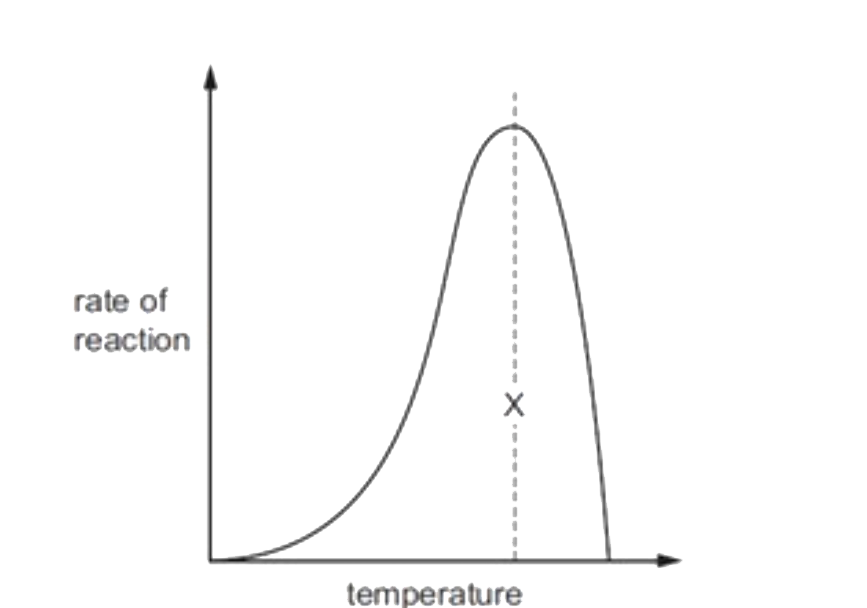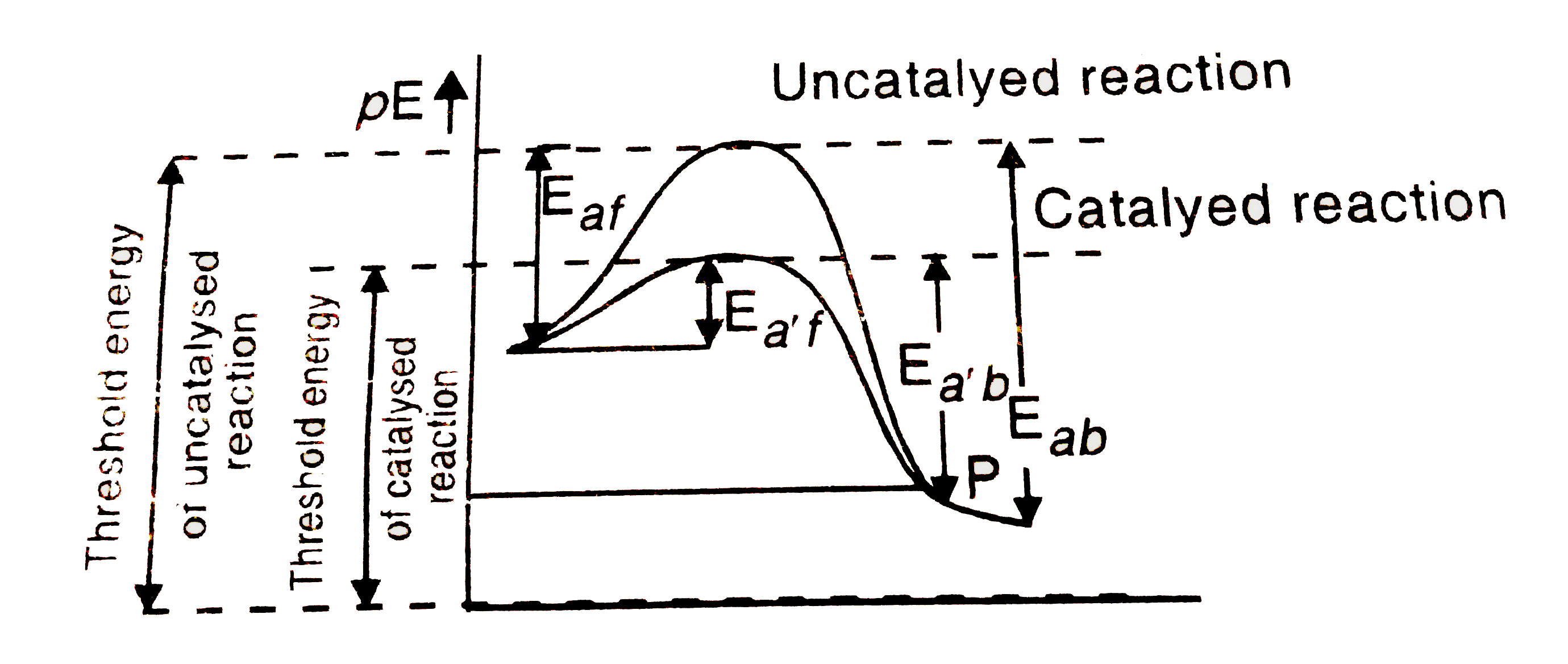(i) Temperature, pH and concentration of substrate can influence enzyme activity ?
(ii) ES complex is short lived and dissociates into products (P)
(iii) In exothermic reaction, the energy level of "P" is lower than "S" substrate
(iv) Cofactors play a crucial role in the catalytic activity of the
enzyme.
Which of the above statements are correct ?
i, iii and iv
ii and iv
i, ii and iv
i, ii, iii and iv
The correct Answer is:D
Step by step video, text & image solution for (i) Temperature, pH and concentration of substrate can influence enzyme activity ? (ii) ES complex is short lived and dissociates into products (P) (iii) In exothermic reaction, the energy level of "P" is lower than "S" substrate (iv) Cofactors play a crucial role in the catalytic activity of the enzyme. Which of the above statements are correct ? by Biology experts to help you in doubts & scoring excellent marks in Class 12 exams.
Similar Questions
The graph shows the effect of temperature on the rate at which the enzyme in a biological washing powder digests and removes fruit juice stains .

Which statements explain the shape of the graph at temperatures higher than X ?
I. Bonds are broken between the R groups of the amino acids in the polypeptide chains of the enzyme.
II. There are more collisions between the enzyme and its substrate.
III. The tertiary structure of the enzyme is altered.
Iv. The shapes of the active site and the substrate are no longer complementary .View SolutionAmong the statement given below, which statements /s is / are correct regarding the relationship between enzyme and substrate ?
I. Above a certain concentration of substrate , an enzyme reaches its maximum rate of reaction
II. Increasing the substrate concentration to a higher level doesn't reverse the effects of a competitive inhibitor.
III At high substrate concentration , a non competitive inhibitor no longer affects the enzyme activity .
IV. The higher the concentration of substrate the faster an enzyme can cataylse a reaction.View Solution
Knowledge Check
- Question 1 - Select One
Read the following statements carefully :
( i ) primary succession is a very slow process taking thousands of years for the climax to be reached.
(ii) The energy at a higher trophic level is always more than at a lower level
(iii) Bacterial and fungal enzymes degrade detritus into simple inorganic substances. This process is called fragmentation .
(iv ) All succession, whether taking place in water or on land, proceeds to a similar climax community : the mesic condition . Which of the two above statements are correct ?A(i) and (ii)B(ii) and (iii)C(i) and (iv)D(iii) and (iv) - Question 2 - Select One
Enzymes are biocatalysts that catalyse reactions at very high rates compared to chemical catalysts. They are specific to the substrate and reaction they catalyse. A few statements about enzymes are made below:
(i) Not every enzyme is proteinacious in nature.
(ii) Some RNAs also are enzymes.
(iii) The active site of the enzyme is complementary to the transition state.
(iv) Enzymes alter the equilibrium constant of the reaction
(v) Enzymes catalyse only irreversible reactions.
Which of the above statements are true?A(i), (ii) and (iii)B(ii), (iii) and (iv)C(iii), (iv) and (v)D(i), (ii) and (v) - Question 3 - Select One
Read the following statements carefully :
( i ) primary succession is a very slow process taking thousands of years for the climax to be reached.
(ii) The energy at a higher trophic level is always more than at a lower level
(iii) Bacterial and fungal enzymes degrade detritus into simple inorganic substances. This process is called fragmentation .
(iv ) All succession, whether taking place in water or on land, proceeds to a similar climax community : the mesic condition . Which of the two above statements are correct ?A(i)& (ii)B(ii) & (iii)C(i)&(iv)D(iii) & (iv).
The steps in catalytic cycle of an enzyme action are given in random order -
I. The enzyme releases the products. Now enzyme is free to bind another substrate
II. The active sites, now in close proximity of substrate breaks the bond of substrate and E-P complex forms
III. Binding of substrate induces the enzyme to alter its shape fitting more tightly around the substrate
IV. The substrate binds to the active site of enzyme (i.e. fitting into the active site.
The correct order is -View SolutionRead the following four statements (A-D) :-
(A) Thermal stability is an important quality of enzymes which are isolated from thermophilic organisms.
(B) Formation of Enzyme substrate complex, during enzyamtic reaction, is an facultative phenomenon.
(C) Enzymes bring down the energy barrier between substrate and transition state to make the transition of substrate to product easy.
(D) The essential chemical components of many coenzymes are proteins and viatmins.
How many of the above statements are right ?View SolutionArrange the steps of catalytic action of an enzyme in order and select the correct option
I. The enzyme releases the products of the reaction and the enzyme is free to bind to another substrate
II. The active site of enzyme is in close proximity of the substrate and breaks the chemical bonds of the substrate
III. The binding of substrate induces the enzyme to alter its shape fitting more tightly around substrate.
VI. The substrate binds to the active site of the enzymeView SolutionConsider the following statements about intermolecular and intramolecular hydrogen bonds .ltbr gt I. Both types of H-bonds are temperature dependent.
II. Intramolecular H- bonds disapperears on increaassing the concentration
III. Intrmolecular H-bonds disppears on decreasing the concentration
IV. The boiling point of compounds having intramolecular H-bond are lower than that of those campounds which have intermolecular H- bonds
Which of the statement given above are correct ?View SolutionThe energy profile diagrams are very important tool through which, we predict lot of things, like the amount of activation energy of the catalysed and uncatalysed reaction as well as for the backward reaction and forward reaction. Thershold energy of the catalysed and uncatalysed reaction. The graphs representing the energy profile diagram for catalysed and uncatalysed reactions are given below :

The graph of the lower energy barrier is the energy profile diagram for the catalysed reaction adn of the higher barrier is the energy profile diagram of uncatalysed reaction.
From the graph, it is clear that EafandEab are the activation energy of the respectively. EafandEab are the activation energy of the catalysed forward and backward reaction respectvely
The reaction which occurs by absorption of heat is known as endothermic reaction and by release of heat is known as exothermic reaction
For exothermic reaction, ΔH is negative and for endothermic reaction, ΔH is positive
From Arrhenius equation, we know that k=Ae−Ea/RT where k is rate constant which signifies effective number of collisions. A is known as Arrehnius constant, or maximum rate constant of frequency factor which signifies maximum number of collisions with proper orientation of reacting species per mole per second.
The catalysed reaction occurs at 500 K and the uncatalysed reaction occurs at 800 K in such way so that the rate of catalysed reaction and uncatalysed reaction becomes equal as well as the catalyst lower down the energy barrier by 60 J.
Answer the following questions on the basis of above paragraph
Which of the following statement(s) is/are correct about the catalysed and uncatalysed reaction ?View Solution

